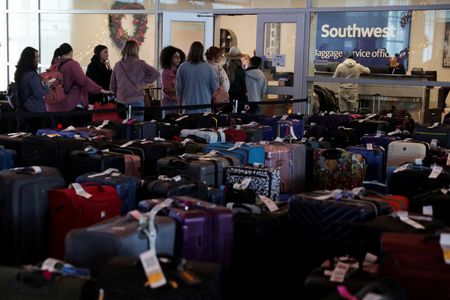By Rajesh Kumar Singh
CHICAGO (Reuters) -Southwest Airlines promised on Thursday a thorough review of an operational collapse that stranded thousands of passengers at the end of the year after a union leader said the carrier had not identified how to avoid a repeat.
Tom Nekouei, vice president of the airlines’ pilots association, told Reuters he was among union leaders in a conference call with Chief Executive Bob Jordan on Monday to discuss the disruption after a winter storm forced cancellation of nearly 16,000 flights.
On the call, details of which have not been reported before, Nekouei said Jordan told them the company had not yet identified a corrective plan of action to avoid a repeat of a cascade of flight cancellations.
“They don’t know what it is that they’re going do in terms of corrective action because they haven’t sat down and run the post-mortem on it,” he told Reuters.
Later on Thursday, Jordan posted a video to the company’s website inviting the union to participate in a thorough review of the disruption that he said would be completed “swiftly.”
The pilots union, which represents almost 10,000 Southwest pilots, estimates the flight cancellations could cost up to $1 billion in lost revenue, Nekouei told Reuters.
Brokerage Raymond James estimated the meltdown could cut Southwest’s projected revenue growth by more than half in the fourth quarter, equivalent to a hit of about $515 million in lost revenue.
Southwest is also facing regulatory scrutiny and a lawsuit.
The White House has said Southwest “failed its customers”. Citing the carrier’s meltdown, lawmakers have been pressing the Biden administration to hold airlines accountable for mass flight cancellations.
The pilots union, which is in heated contract negotiations with Southwest, on Dec. 31 published a letter signed by Nekouei, denouncing company leadership as a “cult” that has spent the last 15 years destroying the airline’s legacy. Before the recent crisis, Southwest had cultivated a reputation for reliable customer service, humorous flight crews and low-cost flights.
Jordan said the airline had made “great progress” in processing tens of thousands of refunds and reimbursements. It had also delivered the vast majority of bags, which went missing, to customers, he said.
DATED TECHNOLOGY
Southwest unions have blamed the company’s “outdated” technology and processes for the biggest operational meltdown in its five-decade history.
Nekouei said the company’s failure to revamp its dated scheduling system that sends crews around the country as passengers for their flying assignments left it vulnerable to “more frequent and more severe” meltdowns. The pilots union has called that so-called “deadheading” practice fatiguing and inefficient.
Nekouei said the same issues led to a major meltdown at Southwest after a thunderstorm in Florida in October 2021 that cost it $75 million.
To be sure, the airline has been upgrading its technology in phases.
In 2017, it replaced its entire reservations system, and four years later it enhanced technology at its maintenance department. Recently, it has made investments in digital scanners to make its baggage handling system more efficient.
Jordan said the company spends about $1 billion a year on technology and will continue to upgrade the tools and processes its employees use to deliver “reliable and low-cost air travel.”
Union officials, however, have called the pace of investment too slow.
“Every meltdown that we’ve had, it’s gotten more severe,” Nekouei said. “It’s become more frequent now and it takes longer and longer to recover from them.”
(Reporting by Rajesh Kumar Singh, editing by Nick Zieminski and Stephen Coates)

